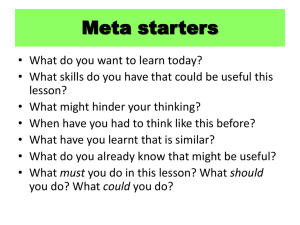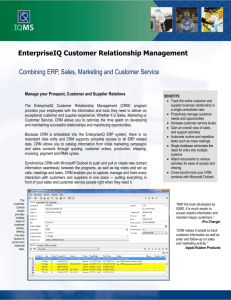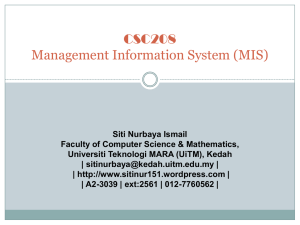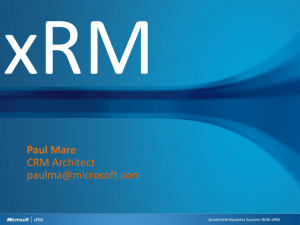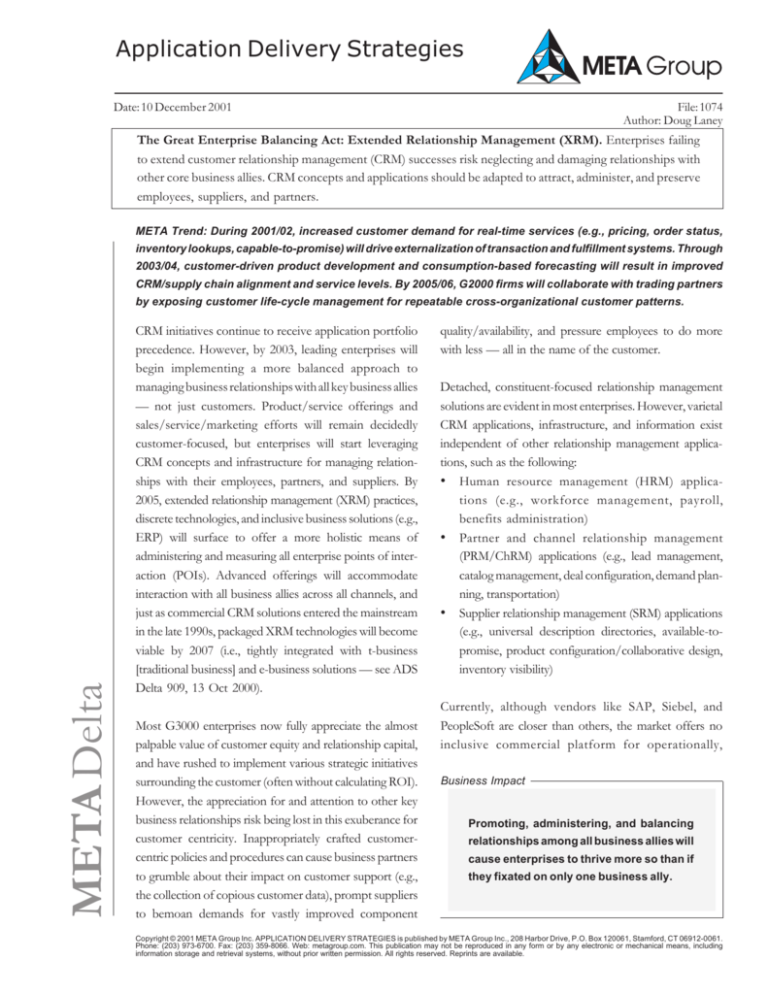
Application Delivery Strategies
Date: 10 December 2001
File: 1074
Author: Doug Laney
The Great Enterprise Balancing Act: Extended Relationship Management (XRM). Enterprises failing
to extend customer relationship management (CRM) successes risk neglecting and damaging relationships with
other core business allies. CRM concepts and applications should be adapted to attract, administer, and preserve
employees, suppliers, and partners.
META Trend: During 2001/02, increased customer demand for real-time services (e.g., pricing, order status,
inventory lookups, capable-to-promise) will drive externalization of transaction and fulfillment systems. Through
2003/04, customer-driven product development and consumption-based forecasting will result in improved
CRM/supply chain alignment and service levels. By 2005/06, G2000 firms will collaborate with trading partners
META Delta
by exposing customer life-cycle management for repeatable cross-organizational customer patterns.
CRM initiatives continue to receive application portfolio
precedence. However, by 2003, leading enterprises will
begin implementing a more balanced approach to
managing business relationships with all key business allies
— not just customers. Product/service offerings and
sales/service/marketing efforts will remain decidedly
customer-focused, but enterprises will start leveraging
CRM concepts and infrastructure for managing relationships with their employees, partners, and suppliers. By
2005, extended relationship management (XRM) practices,
discrete technologies, and inclusive business solutions (e.g.,
ERP) will surface to offer a more holistic means of
administering and measuring all enterprise points of interaction (POIs). Advanced offerings will accommodate
interaction with all business allies across all channels, and
just as commercial CRM solutions entered the mainstream
in the late 1990s, packaged XRM technologies will become
viable by 2007 (i.e., tightly integrated with t-business
[traditional business] and e-business solutions — see ADS
Delta 909, 13 Oct 2000).
Most G3000 enterprises now fully appreciate the almost
palpable value of customer equity and relationship capital,
and have rushed to implement various strategic initiatives
surrounding the customer (often without calculating ROI).
However, the appreciation for and attention to other key
business relationships risk being lost in this exuberance for
customer centricity. Inappropriately crafted customercentric policies and procedures can cause business partners
to grumble about their impact on customer support (e.g.,
the collection of copious customer data), prompt suppliers
to bemoan demands for vastly improved component
quality/availability, and pressure employees to do more
with less — all in the name of the customer.
Detached, constituent-focused relationship management
solutions are evident in most enterprises. However, varietal
CRM applications, infrastructure, and information exist
independent of other relationship management applications, such as the following:
• Human resource management (HRM) applications (e.g., workforce management, payroll,
benefits administration)
• Partner and channel relationship management
(PRM/ChRM) applications (e.g., lead management,
catalog management, deal configuration, demand planning, transportation)
• Supplier relationship management (SRM) applications
(e.g., universal description directories, available-topromise, product configuration/collaborative design,
inventory visibility)
Currently, although vendors like SAP, Siebel, and
PeopleSoft are closer than others, the market offers no
inclusive commercial platform for operationally,
Business Impact
Promoting, administering, and balancing
relationships among all business allies will
cause enterprises to thrive more so than if
they fixated on only one business ally.
Copyright © 2001 META Group Inc. APPLICATION DELIVERY STRATEGIES is published by META Group Inc., 208 Harbor Drive, P.O. Box 120061, Stamford, CT 06912-0061.
Phone: (203) 973-6700. Fax: (203) 359-8066. Web: metagroup.com. This publication may not be reproduced in any form or by any electronic or mechanical means, including
information storage and retrieval systems, without prior written permission. All rights reserved. Reprints are available.
Building Firm PECS. Leading enterprises appreciate that
they are the PECS-connecting ligament, and that holistically
attracting, sustaining, and leveraging these allies is key to
achieving enterprise objectives (see ADS Delta 955, 20 Feb
2001). Through enterprise (not stovepipe) analytics, organizations should continually assess how business policies,
plans, and processes affect each ally, and strive for a
balance of performance-oriented and satisfaction-oriented
indicators across them. Operationally, business systems
should be designed to accommodate the input from, the
workflow among, and the output to each business ally.
By 2004, operational XRM solutions will be formed via the
convergence of the CRM technology ecosystem — initially
focused on operational CRM — and ERP applications
(e.g., leveraging sales automation software to handle supplier contacts/contracts), and collaborative XRM solutions
will be formed via the expansion of existing collaborative
CRM applications to accommodate non-customers (e.g.,
leveraging existing call center collaborative applications and infrastructure to handle employee benefits
or supplier payment inquiries — see ADS Delta 810,
29 Dec 1999). Advanced XRM solutions will also
manage relationships with secondary business allies
(e.g., local/federal/international government, community, industry organizations, investors, associative
PECS, even competitors).
One-to-One or “One for All and All for One”?
Conventional wisdom and many customer relationship
gurus spout that CRM nirvana is achieved through custom
marketing of one’s offerings (at the right time and place) to
an individual prospect — a.k.a. “one-to-one marketing.”
However, we regularly observe higher levels of enterprise
CRM self-realization and success by pulling suppliers and
partners into the marketing encounter. Of course, this
introduces desirable commerce efficiencies (see ADS
Delta 964, 14 Mar 2001, and ED Delta 141, 8 Mar 2001)
and can augment enterprise value. Customers understand
fully that an enterprise’s value is derived not solely from its
own offerings and employees, but also from the aggregate
strength of its partner and supplier relationships. We
strongly advise enterprises to become more adept at
introducing integrated partner goods/services to prospects, thereby proffering a more complete solution and
exposing supplier/prospect capabilities/requirements more
readily to improve component-level satisfaction (i.e., real
value) and expectation management (i.e., perceived value).
Therefore, through 2003, customers/prospects will observe a substantial increase in the presence of partners and
suppliers at channels and POIs throughout the customer
life cycle.
Peer Pressure to Expose One’s Privates. Already,
research from our most recent enterprise analytics industry
study indicates that making the enterprise’s data warehouse
(or parts thereof) available to suppliers and partners breeds
higher levels of success. Through 2003, XRM solutions will
further incite the outward expansion of information supply
chains (ISCs), so that operational, collaborative, and analytical information can be made available to PECS. As a result,
enterprises must conceive and implement policies and
processes to safeguard all private PECS information. By
2005, information will frequently be privacy-tagged, and
interchange standards will evolve (e.g., from CPExchange
and P3P) to limit the exposure of personally identifiable
information. By 2006, mechanisms based on these interchange standards will be embedded within XRM solutions
and offered as application services. By 2007, most G3000
enterprises will employ policies and deploy procedures to
limit their liability by rejecting external information that lacks
certifiable privacy (and quality-related) metadata tags.
Bottom Line
Enterprises should not forgo or belay CRM efforts, but must ensure they are not executed at the expense of
a harmonious relationship with other business allies (i.e., partners, suppliers, and employees). Prior to the
emergence and viability of commercial extended relationship management (XRM) applications, enterprises
should also consider how their CRM concepts, applications, infrastructure, and information might be
repurposed, extended, or scaled to accommodate points of interaction with these other groups.
Copyright © 2001 META Group Inc.
ADS 10 Dec 01.1074
META Delta
collaboratively, and analytically managing all relationships
with all major business allies (e.g., partners, employees,
customers, suppliers [PECS]), across all channels and POIs
(e.g., storefront, Web, e-mail, telephone) and throughout
the entire life cycle (engage/transact/fulfill/service [ETFS]
— see Figures 1-4 in Addendum). Through 2005, those
organizations with stovepiped relationship management
applications will suffer expensive, ongoing application
integration efforts to coordinate them.
Application Delivery Strategies
Date: 10 December 2001
File: 1074 Addendum
Figure 1 — Adopting the ETFS Life-Cycle Model for XRM (Examples)
Engage
Partner:
Joint marketing agreement (such as predecessor to reseller agreement)
Employee:
Recruiting, interview process
Customer:
Marketing, sales process
Supplier:
Testing supplier offerings/abilities
Transact
Partner:
Lead/deal management arrangement, contract terms
Employee:
Job offer/acceptance
Customer:
Credit card authorization
Supplier:
Volume/service-level agreement
Partner:
Provisioning marketing materials, samples
Employee:
Orientation/training, supplies, work environment, work product, payroll
Customer:
Delivery of finished goods or services
Supplier:
Delivery of raw materials or components
Fulfill
Service
Partner:
Marketing/RFP support, product planning
Employee:
Evaluations, benefits
Customer:
Product support, returns
Supplier:
Demand forecast, service-level reporting
Source: META Group
Figure 2 — Extending CRM
Sphere of Business Allies
META Delta
•
•
“E” drastically increases the
need for adaptive collaborative
relationships among partners,
employees, customers, and
suppliers (PECS)
Extended relationship
management (XRM) emerges to
build firm PECS alliances
• Standardized point-to-point
PARTNERS
HR
Customer
Service
Inventory
E MPLOYEES
Financials
XRM
Product
Process
Sales
Marketing
SUPPLIERS
CUSTOMERS
(P2P) data interchange and
external application integration
enable cooperation
Highly successful enterprises are pragmatic about
extending their “infostructure” beyond merely customers
Source: META Group
Copyright © 2001 META Group Inc. APPLICATION DELIVERY STRATEGIES is published by META Group Inc., 208 Harbor Drive, P.O. Box 120061, Stamford, CT 06912-0061.
Phone: (203) 973-6700. Fax: (203) 359-8066. Web: metagroup.com. This publication may not be reproduced in any form or by any electronic or mechanical means, including
information storage and retrieval systems, without prior written permission. All rights reserved. Reprints are available.
•
OBJECTIVES
OBJECTIVES
• Improved
Improvedinteractions
interactionsand
andgood-will
good-willwith
withpartners,
partners,employees,
employees,customers,
customers,
and
andsuppliers
suppliers
• Optimized
Optimizedbusiness
businessperformance
performance(sell-side,
(sell-side,buy-side,
buy-side,and
andin-side)
in-side)
• Minimized
Minimizedchurn
churn++turnover
turnover++flight
flight
•
ACTIONS
ACTIONS
• Reapply
Reapplycustomer-centric
customer-centricphilosophies
philosophiesand
andbehaviors
behaviorsto
toall
allrelationships
relationships
Implement
visible
XRM
strategies
to
engage,
transact,
fulfill,
• Implement visible XRM strategies to engage, transact, fulfill,and
andservice
service
all
allPECS
PECSallies
allies
• Repurpose
Repurposeinformation
informationand
andinfrastructure
infrastructureto
toenable
enableXRM
XRMprograms
programs
•
CHALLENGES
CHALLENGES
• “We
“Wehaven’t
haven’teven
evengot
gotCRM
CRMright
rightyet!”
yet!”
Maintaining
a
balanced
approach
• Maintaining a balanced approach
Build out CRM concepts and components for command
and control of e-commerce complexity
Source: META Group
Figure 4 — XRM Dimensions
Managing all varieties of business process …
Operational, collaborative, analytical
… for all points of interaction …
Storefront, Web, e-mail, telephone, etc.
… among all major business allies …
Partners, employees, customers, suppliers (PECS)
… across their entire life cycle.
Engagement, transaction, fulfillment, and service (ETFS)
Source: META Group
Copyright © 2001 META Group Inc.
ADS 10 Dec 01.1074 Addendum
META Delta
Figure 3 — Reaching for XRM


